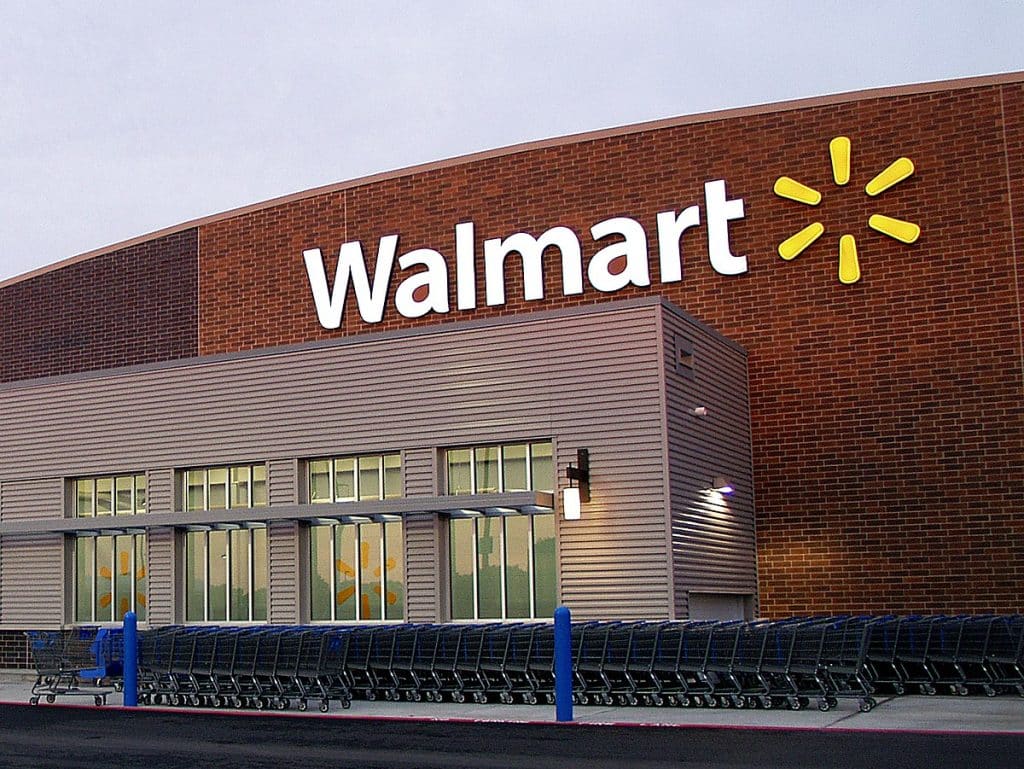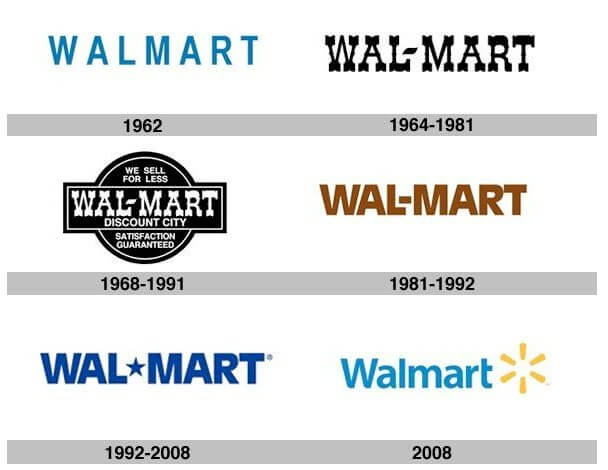Big box retailers are certainly not few and far between. Drive to any populated town, in any state, and you’ll likely find a Target, Home Depot, Kohl’s, or another chain that has exactly what you are looking for. There’s one chain though that stands out from the crowd and has stood the test of time – and that chain is Walmart.
Read on below to not only learn more about the brand with a logo so recognizable that you can spot it a mile away, but also to learn how Walmart’s logo has kept the brand growing since 1962.
Meet Walmart
Walmart was founded with a simple strategy in mind, to always offer the lowest prices anytime, anywhere. 60 years later and that strategy still exists because what Walmart was built on was an unshakeable foundation.
Walmart started as just one storefront in Rogers, Arkansas to help people save money so they could live better and easier. Today, Walmart has become a retail powerhouse, becoming the most successful store chain in the world. Walmart has grown to be a multinational retail corporation that operates a chain of supercenters, discount department stores, pharmacies, and grocery stores across not only the United States, but also the world.
As you read on, you’ll learn more about what has contributed to Walmart’s growth, and you’ll even learn of some pitfalls the brand has encountered. Despite what the brand has endured and experienced, they still have remained the go-to supplier for a wide array of products and services.
Walmart’s Evolution
1962: Wal-Mart is founded
On July 2, 1962, Sam Walton opened his first Wal-Mart store in Rogers, Arkansas. Walton was a businessman and former J. C. Penny employee. Before opening Wal-Mart, Walton experimented with a physical storefront, first opening his first, non-Wal-Mart retail store in 1950. He tried out what would be Wal-Mart’s claim to fame in these stores, offering lower prices than all his competitors. This straightforward business model initially hindered his profit margins but in just a few years, his sales made up the difference.
When it came time to open the first Wal-Mart store, Walton gained inspiration from Ann & Hope and FedMart, whose names he was drawn to.
1967-1969: Wal-Mart begins to expand
Walton’s business model of offering lower prices than his competitors worked, and it was a successful enough model for him to open 24 stores across Arkansas by 1967. These stores collectively generated $12.7 million in revenue. Two years later in 1969, Wal-Mart officially became incorporated as Wal-Mart Stores, Inc.
1970 – 1979: Wal-Mart becomes a national chain and expands their offerings
Shortly after Wal-Mart became incorporated, its first stock was sold as a publicly-traded company in 1970 for $16.50 a share. By 1972, the stock was listed on the New York Stock Exchange. Their success with the stock market was a direct result of the company’s growth.
In 1971, Wal-Mart’s first distribution center and Home Office opened in Bentonville, Arkansas and by 1972, Wal-Mart had its best year of sales yet with $78 million generated from 51 stores (including stores outside of Arkansas). Wal-Mart kept growing and opened its first pharmacy in 1978 and started the Walmart Foundation in 1979.
1980-1988: Wal-Mart doesn’t slow down
To kick off the next decade, Wal-Mart reached $1 billion in annual sales. This was faster than not just any of their competitors, but any other company previously. What drove these sales were the number of stores Wal-Mart had. In 1980, Wal-Mart had 276 stores, employing 21,000 associates.
Three years later in 1983, Wal-Mart opened its first Sam’s Club store in Midwest City, Oklahoma. Sam’s Club was different than Wal-Mart, offering bulk products, but also like Wal-Mart in that it offered cheap prices. This same year, Wal-Mart swapped out its current cash registers for computerized point-of-sale machines. 5 years after they topped $1 billion in sales, Wal-Mart achieved sales that reached $8.4 billion in 1985 and expanded their chain even more across the nation with 882 stores.
The same year that the first Wal-Mart Supercenter opened in Washington, Missouri, in 1988, Sam Walton also stepped down as CEO. Walton was replaced by David Glass.

1991 – 1998: Wal-Mart becomes the top national retailer and expands globally
After Wal-Mart successfully had locations in all 50 states and had record sales of $32 billion, the chain expanded globally in 1991. This year they opened Sam’s Club in Mexico City, while also launching their first optical location in the states. From there, more stores opened globally throughout the 90’s – with locations in Canada, China, and the United Kingdom. By 1997, Wal-Mart also had its first $100 billion sales week, which speaks to its success.

2000-2019: Wal-Mart adapts and stays relevant
The internet took off in 2000 and Wal-Mart adapted by creating an online experience for their customers. In 2016, Wal-Mart also launched Walmart Pay to help customers seamlessly make payments from their smartphones in-store. That was just the beginning of their response to the changing times. Wal-Mart went on to expand into Japan, India, South Africa, and Chile, committed to being an environmentally sustainable company, offered free shipping options, and exceeded $400 billion in annual sales.
Their leadership transitioned throughout the years, changing CEOs countless times throughout the 2000s, and they acquired several companies including Jet.com, Moosejaw, ModCloth, Bonobos, Parcel, Shoes.com, and more. In 2018, Wal-Mart Stores, Inc. changed its legal name to Walmart Inc. And just before the pandemic, John Furner was named the new President and CEO.
Roadblocks Along the Way
Being a big-box retailer does come with some challenges. Because the brand is so recognizable and so many people know the store, the brand falls victim to opinions from everyone about their every move. Analysts track sales closely which influences the stock market, and with tech constantly evolving, Walmart needs to keep up with the latest trends.
Regarding Walmart’s logo, throughout the years you’ll see below that the logo has not varied extensively. Critics say that the logo is uninspired and that the “spark” doesn’t resemble an actual spark. This has caused many critics to not understand or to be concerned why an entirely new logo was never actually explored (especially when Walmart is up against Target’s giant red bullseye).
The Meaning of Walmart’s Logo and Walmart’s Logo History

Just like with many other brands that have been around for 50+ years, the Walmart logo has gone through various iterations. The reasons for their logo changes varied, but the most prominent drive for change came when Walmart was attempting to rebrand its image. Previously, Walmart was associated with low prices and cheaper quality. Walmart went through a rebranding to change this “lower-quality” message of their company.
Below we’ll take you on a deeper dive into all the various Walmart logos.

1962-1964: The first version of the Walmart logo
o was simple, with no elaborate features or details. This logo was plain, solely featuring simple blue letters which spelled out the store name.
1964-1981: The second version of the Walmart logo
The second Walmart logo had more stylistic components, resembling a western theme with the lettering. This second iteration also incorporated a hyphen breaking up “Wal” and “Mart.”

1981-1992: The third version of the Walmart logo
20 years after the western-themed logo, Walmart decided to rebrand and embark on a different direction. This logo had a bold look and font, while still incorporating the hyphen in the name.

1992-2008: The fourth version of the Walmart logo
In this iteration, Walmart went for a more modern look and played around with swapping out the hyphen for a star. Walmart also transitioned back to the blue coloring. This fourth version can still be seen on many storefronts as the company still works to replace this version with the latest one.
2008 – present: The fifth version of the Walmart logo
This fifth version underwent the most extreme changes. In 2008 the logo transitioned to lowercase letters followed by a yellow sunburst, which is called “the spark.” This logo was the result of Walmart’s rebranding to appeal to an audience that comes from a higher income bracket. While logos won’t solely cause shoppers to change their behavior and begin shopping at a store, they can still help change the perception that people have. This latest iteration is softer, friendlier, and warmer and Linda Blakley, the spokeswoman for the Bentonville, Arkansas chain said that the sunburst addition embodies their company’s mission of “innovation, inspiration, and people working hard to bring prices down.”
More Details About The Walmart Logo
Walmart’s logo font:
Besides the frontier font Walmart once used, the store has mainly opted for a sans-serif font in the recent iterations. This font is a simplistic sans-serif variation with simple, thick lines and smooth angles. In the current logo, the font is a Myriad Pro-Bold, which still incorporates manly elements from the prior sans-serif variations.
Walmart’s logo color:
Walmart’s logo has transitioned from blue to black to brown to blue again. The latest iteration was created with a softer blue and yellow color palette. The goal of this color scheme was to be more welcoming and inviting to customers globally, while also attracting a new clientele due to its aesthetically pleasing nature.
Walmart’s logo symbols:
The only symbol that has ever been featured in the Walmart logo is the recent addition of the sunburst. This sunburst symbolizes six sparks, where each spark symbolizes an idea that has made Walmart so successful. Additionally, the sunburst was chosen because it represents the steps Walmart has taken to be an eco-friendly company.
Walmart Today
Walmart hasn’t slowed down since its first store was launched in 1962. Today, Walmart is one of the world’s largest employers, employing nearly 2.2 million employees across the globe. Walmart has continued to launch new initiatives including Walmart+ which is a membership program that was started in 2020 to help their customers save even more money.
Walmart today has continued advancing with partnerships, new acquisitions, investment opportunities, and charitable contributions. With over 5,200 stores in the United States and over 6,000 stores internationally, Walmart has continued to generate hundreds of billions of dollars year after year with no plans to slow down any time soon.
Lessons Learned from Walmart
Walmart teaches a valuable lesson in logo redesign. Unlike some companies that go through a major rebranding, Walmart’s logo through the years only had subtle updates. While some may see the logo as uninspiring and plain, Walmart’s logo has lasted because it works for the brand. Walmart never needed to release a logo that was innovative or entirely different, it just needed to be different enough from their last logo. Even just the smallest changes represented a new beginning and direction for Walmart.
If you are considering rebranding your company, look at your current logo. Are there just certain elements you can update? Are there only certain components that don’t seem to be resonating with your audience? While your initial reaction may be to drastically alter your company’s logo, it may not be necessary. At Walmart, that was the case. They realized that while they needed a new logo to showcase their new strategy, they didn’t need to change their image drastically. By slowly incorporating a logo with a new font, color, and soft features, they were able to highlight the updated vision of their company.
As a business owner, you feel the weight of making the decisions related to your company’s branding. Crafting a logo that showcases your company’s mission, vision, and purpose is easier said than done. At Hatchwise, our job is to make this process easier for you. All you need to do is start a logo contest at Hatchwise and you’ll find that our team of professionals will provide you with countless options that you can choose your new logo from.
If you have any questions, we’re here to help! Just get in touch with our team today to chat more and launch your own logo contest.


















